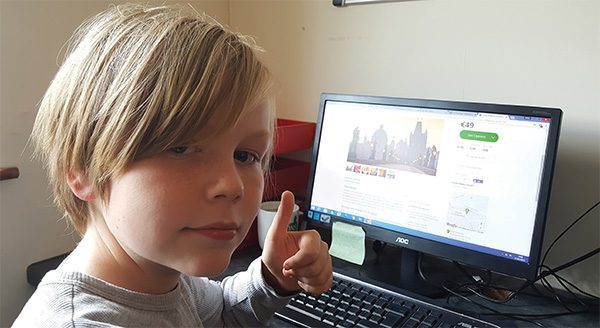
CoderDojo ninja Ed Nicell checks out the computers in NewsFour. Picture by Jennifer Reddin
On Saturday June 17th, more than 1,000 CoderDojo ninjas from all over the world descended on the RDS to showcase their creative projects at the CoderDojo Coolest Projects expo, which is now the largest kids’ tech event in Europe. CoderDojo Coolest Projects is both an exhibition and a competition. It was started six years ago to inspire and encourage creativity, innovation, technology skills and entrepreneurship in young people aged from 7 and 17, who are part of the CoderDojo movement.
Amongst the winners at this year’s event was a local boy, Ed Nicell, who attends the Star of the Sea CoderDojo in Sandymount, Dublin 4. Ed won first place in the aged 10 Scratch category for his project “Geometry Dash 2 (Fanmade)”, an unofficial sequel to the popular Geometry Dash game.
Despite his love for technology and his aptitude for coding, 10-year-old Ed was surprised to hear that his project had won first prize. “I actually thought I was dreaming so I pinched myself on the way up,” he says modestly. He happily shares the credit for his success with his “awesome” mentors and his peers at the Sandymount club, where the kids learn how to teach themselves coding by having ideas, trying things on the computer, using online resources and by helping each other.
At the Star of the Sea Primary School in Sandymount, Ed’s favourite subject is “definitely computing.” When he started going to CoderDojo about three years ago he already had some computer skills; he started playing games on his dad Michael’s Nintendo DS when he was only three years old. Already, he is considering a future in games development and together with a group of friends has formed a group called Nitro which he says “is not exactly a company yet because you can’t have a company until you are 18…so it’s a group. We make games and basically we treat it as if it were a company.”
Apart from coding, Ed likes swimming and hanging out with his brothers Arthur and Saul, his cousin Tadgh and his friends. Arthur and Tadgh are also members of the CoderDojo and computing is a common interest.
Celie, Ed’s mum, makes sure that they keep up with other interests and limits the time they spend on computers to “about half-an-hour a day and a bit longer at weekends” which she says “is not a huge amount of time but it’s amazing what they can learn in a short time.” Celie believes that the kids experience at CoderDojo has been “absolutely brilliant” and would recommend it to other parents saying, “if your children are interested in computers then it’s a great thing to send them to.”
CoderDojos have been teaching kids to code since 2011. The movement was started by Corkman, James Whelton, who set up a computer club in his school when he was just 18, to teach his fellow students basic HTML and CSS. Later that year, entrepreneur and philanthropist Bill Liao expressed an interest in growing the project. Together they founded the CoderDojo movement with a mission to provide “every child worldwide with the opportunity to learn code and to be creative with technology in a safe and social environment.” To achieve this they decided to open-source the model, making it easier to share. Making the movement open-source allowed thousands of mentors to set up
CoderDojos and today at as many as 1,300 dojos in 70 countries, children are learning to code for free and availing of the opportunity to move beyond the role of passive tech-consumers to become creators and tech-contributors in their own right.
The clubs vary in size and style. Some are structured and some are more free form. All of them encourage the young participants to develop coding and tech skills at their own pace. Most dojos cater for both complete beginners as well as for children who already know a lot about coding.
The CoderDojo movement is now a global phenomenon with clubs from Dublin to London to Cork and even in places like Uzbekistan, Madagascar and Istanbul. Since the first CoderDojo was set up, over 100,000 young people have participated in the venture and more than one-million hours have been volunteered by around 9,000 individual mentors.
Here in Sandymount, Ed is already tinkering around with other game engines such as Unreal engine and Unity, in preparation for his next project, although he has no definite plans yet. He’s moved on from Scratch to MIT App Inventor and has started work on his own web browser which “is still in the development stage.” Speaking to NewsFour he comes across as a cool, articulate, curious and focused young person. No matter what he chooses to do in the future, there is little doubt that he will do it well.
by Jennifer Reddin



